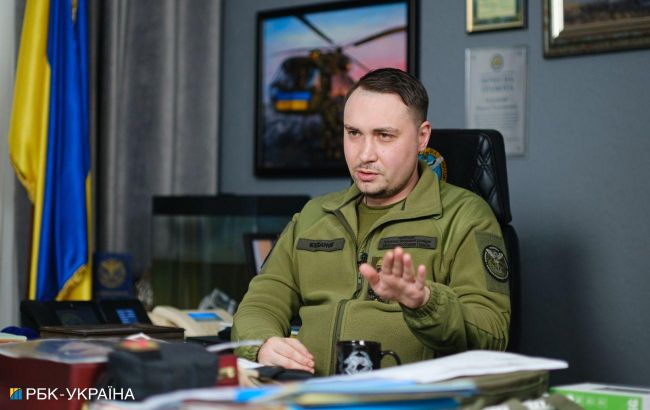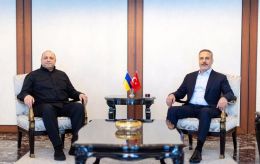Warned about invasion and promises to liberate Crimea: Facts about Defense Intelligence Chief
 Head of the Defense Intelligence of Ukraine Kyrylo Budanov (photo: Vitalii Nosach, RBC-Ukraine)
Head of the Defense Intelligence of Ukraine Kyrylo Budanov (photo: Vitalii Nosach, RBC-Ukraine)
Before the full-scale invasion began, Kyrylo Budanov's personal background was relatively unknown to the general public. The head of the Defense Intelligence of Ukraine primarily worked in the shadows, as is typical of intelligence professionals, especially in the military. However, now he is one of the most prominent speakers who first warned Ukrainians about Russia's impending invasion.
For more information about Kyrylo Budanov, read the article by RBC-Ukraine on Military Intelligence Day.
Injuries and secret operations: Budanov's early years
Kyrylo Budanov was born on January 4, 1986, in Kyiv, and chose a military career, graduating from the Odesa Institute of Ground Forces in 2007. However, a year before graduation, he switched from the airborne faculty to intelligence, which was an unusual decision as the airborne faculty was known for producing future elite paratroopers, always in demand. Nonetheless, the young intelligence officer earned his diploma and immediately started working for Defense Intelligence.
He worked in various positions for 12 years, including units specializing in special operations. According to the intelligence officer, Russia had been preparing for this and subsequent aggression since 2007.
Starting in 2014, he participated in the Russian-Ukrainian war, leading operations and sustaining three injuries. The second injury was particularly severe, as shrapnel from an anti-personnel mine struck his heart, pierced his neck, and penetrated his back.

Photo: Kyrylo Budanov survived three injuries and ten attempts on his life (Vitalii Nosach, RBC-Ukraine)
The third bullet shattered the elbow joint, resulting in issues with bending his right arm. Aside from the injuries, there were ten attempts on his life, with the first occurring in 2016. Three years later, a bomb detonated prematurely under his car.
Since then, Budanov's operations in Crimea began. The first was the "Raid on Crimea," involving the physical elimination of a Russian "Vympel" unit and their commander, considered a "hero" of the Chechen wars. It is believed that Budanov's unit was also responsible for the removal of a high-ranking FSB officer on the peninsula.
Until August 5, 2020, he carried out classified missions. Then, by the decree of President Zelenskyy, at the age of 34, he became the head of the Main Intelligence Directorate under the Ministry of Defense, and later, the Coordinator of the Working Group on Prisoners of War Affairs. With his involvement, the Main Intelligence Directorate managed to return at least 215 Ukrainian defenders home, including 108 members of the "Azov" unit.
In his office, classical music is a constant presence, and various items are strategically placed before interviews with journalists. This is how Budanov conveys silent hints that he cannot openly discuss. On the walls, there are paintings and photos depicting the intelligence agency's achievements, including the evacuation from Kabul in 2021, helicopters flying to the besieged "Azovstal" in Mariupol, and the satellite purchased by all of Ukraine. There are also animals living there: two frogs, birds, and a cat named Gunter.
But Kyrylo Budanov is not only known for this. Or rather, not just for this. He is perhaps the only top official in Ukraine who was absolutely certain about the Russian invasion and even published a map with likely attack directions. Budanov's words and predictions carry significant weight in President Zelenskyy's circle, and he is one of the few with direct access to the country's leader.
The head of the Defense Intelligence has a rather direct style of communication with journalists, which he always embellishes with humor and jokes. Periodically, these jokes are related to the (not very cheerful) future of Russia. Here, Budanov sees two options: either the breakup of the federation into several smaller independent states or the preservation of its integrity with a change in leadership, the return of all occupied territories (not only Ukraine but also the Kuril Islands and Kaliningrad, among others), and the payment of reparations.
Confident in the attack: How Budanov convinced everyone that Russia would dare to invade
November 2021. The concentration and preparation of Russian forces near the borders of Ukraine are being discussed on numerous talk shows in our country and around the world. Expectations and hypotheses are being built and shattered. But the most accurate forecast (although he himself calls them analytical assessments) is provided by Kyrylo Budanov.
He reported that they would approach Kyiv through the Chornobyl Exclusion Zone and the radioactive Red Forest (ultimately, this also became one of the reasons for the Russians' defeat near Kyiv). In the south, they would capture Kherson (which is still the only regional center that the Russian forces managed to capture and hold), and Russian paratroopers would attempt to land in Odesa. Interestingly, very few people in Ukraine paid attention to these predictions at that time.
Budanov even broke down the invasion into actions of specific enemy units and their maneuvers. Intelligence knew the quantity, routes, names, and numbers. All of this was demonstrated on the now-famous map of the offensive. At that time, Russia had concentrated about 92,000 troops near Ukraine.

Photo: The head of GUR was the only one who accurately described and predicted Russia's attack on Ukraine (Vitalii Nosach, RBC-Ukraine)
Budanov described the enemy's actions as follows: initially, airstrikes, followed by artillery shelling, the advance of tanks, airborne landings in the east, attempts to immediately capture Odesa and Mariupol, and an attack with smaller forces through Belarus to create a threat to the Kyiv and Chernihiv regions. Near the borders of Ukraine and Crimea, Russia increased the number of Iskanders for ballistic strikes.
However, the exact date was not known at that time, and it was referred to as "January-February" 2022. The precise date was learned by intelligence officers at around 3:00 PM on February 23. The Kremlin had changed the final day multiple times within two weeks. On the same day, Budanov took his wife to the Defense Intelligence headquarters. They lived in his office, watching the clock.
"If the attack hadn't happened, we, as a special service, would not have looked very good because we specifically warned everyone that it would start at 4-5 in the morning. It may sound strange, but I was afraid that everything would not go according to the scenario," he said in one of his interviews. The Washington Post noted that at that time, Budanov risked his entire career as a top intelligence officer.
Around 4 AM on February 24, GUR special units had already arrived in Hostomel, where the landing of paratroopers was expected at the local airfield.
Speaking of aviation, indeed, most of the combat aircraft were successfully deployed and put into the air promptly. However, the Russians did manage to damage up to 20% of aviation infrastructure objects. Budanov identifies the main setbacks in the initial stage of the war as the breakthrough near Volnovakha and a temporary failure near Severodonetsk. A more overarching failure, according to Budanov, was the partial occupation of Donetsk and Luhansk regions in 2014 and the annexation of Crimea.
It was this low rate of success in hitting targets, in Budanov's view, that hindered Russia from achieving complete air dominance in the early days of the major conflict. Their inability to neutralize (though not numerous) Ukrainian air defense systems led to aircraft losses, which continued to increase.
Russia was losing soldiers as well, to the extent that they had to announce the first population mobilization since World War II. They managed to conscript over 316,000 people. According to Budanov, nobody trained them, and they were immediately sent to the front lines. Often, they lacked equipment because it was either destroyed or obsolete.
When will the war end: Key predictions
About the future victory, Kyrylo Budanov began to speak as early as the spring of 2022. In particular, on April 20, he mentioned that the turning point in the confrontation would come in the second half of August 2022, and the active phase would decline by the end of the previous year. This was because, supposedly, the Russians only had resources for the first 12 months, and the Ukrainian Armed Forces should at least enter the territory of Crimea by then.
In the summer of 2022, Budanov said that Putin would not agree to fight to the last. Otherwise, statehood would collapse. In the winter of 2022, the first prediction about the end of the war emerged: the end of 2023 with the restoration of all borders to those of 1991. On October 28, he predicted the partial destruction of the Kakhovka Hydroelectric Power Station but added that this would not stop the counteroffensive.
In the spring of 2023, Budanov spoke of the decisive, final battle of this war between Russia and Ukraine. Therefore, it is possible to expect its conclusion either this year or in the following year. At present, it is impossible to be more precise. Budanov himself characterizes this timeframe as "the very near future."

